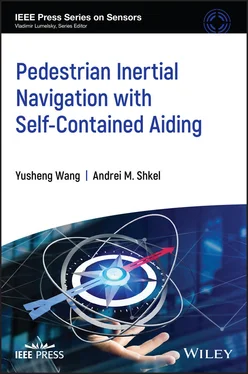1.3.2 IMU Mounting Positions
In pedestrian inertial navigation, depending on the approaches to be taken and the application restrictions, the IMU can be mounted on different parts of body to take advantage of different motion patterns, such as head, pelvis, foot, wrist, thigh, and foot. Pelvis, or lower back, was the first explored IMU mounting position in the literature, because these parts of the body experience almost no change of orientation during walking, which greatly simplifies the modeling process for both strapdown inertial navigation and SHS [15]. In subsequent studies, thigh and shank were explored, such that IMU can directly measure the motion of the leg, which is directly related to the step length by the biomechanical models [16,17]. More recently, in order to integrate pedestrian inertial navigation with smart phones and wearable devices, such as smart watches and smart glasses, pocket, wrist (or hand hold), and head are becoming the IMU mounting positions of interest [18–20]. The foot‐mounted IMU has also been demonstrated for SHS, but this placement of sensors is mostly used in the ZUPT‐aided pedestrian inertial navigation, instead of SHS.
Head‐mounted IMUs are usually used for heading angle estimation, since it experiences lowest amount of shock and almost no change of orientation. Besides, it is usually convenient to mount the IMU on the helmet for first responders and military applications [21]. However, the low amplitude of angular rate and acceleration during walk makes it hard for step length detection. In addition, the gazing direction may not be aligned with walking direction during navigation. Pelvis‐mounted IMUs have the ability of estimating the step length for both legs with one single device, compared to the IMUs mounted on the legs. It is also more convenient to align the IMU to the walking direction compared to the head‐mounted IMUs. Pocket‐mounted IMUs and hand‐held IMUs are mostly developed for pedestrian inertial navigation for use with smart phones. In this approach, the IMU is not fixed to a certain part of the body, and its orientation may change over the navigation applications due to different hand poses and different ways to store the smart phone in the pocket. It makes the SHS algorithm more complicated than other IMU mounting positions. Foot‐mounted IMUs will experience the highest amount of shock and vibration due to the heel shocks during walking [22]. As a result, a more stringent requirement on the IMU performance will be necessary, such as high shock survivability, high bandwidth and sampling rate, low g‐sensitivity, and low vibration‐induced noise [23]. However, with foot‐mounted IMUs, a close‐to‐stationary state of the foot during the stance phases will greatly reduce the navigation errors in the ZUPT‐aided pedestrian inertial navigation.
Between the SHS and the ZUPT‐aided strapdown inertial navigation, the latter is the more widely used approach for precision pedestrian inertial navigation. The main reasons are:
ZUPT‐aided strapdown inertial navigation has demonstrated a better navigation accuracy compared to the SHS. For example, in a navigation with the total walking distance of 20 km, position estimation error on the order of 10 m was demonstrated, corresponding to a navigation error less than 0.1% of the total distance [24]. The navigation error for SHS, however, is typically about 1% to 2% of the total walking distance.
ZUPT‐aided strapdown inertial navigation is more universal compared to SHS, with only one assumption that the velocity of the foot is zero during the stance phase. As a result, it can be applied to many pedestrian scenarios, such as walking, running, jumping, and even crawling. In the case of SHS, it has to classify different motion patterns, if the system has been trained with such patterns, and correspondingly fit the data to different models.
SHS is user‐specified and needs to be calibrated or trained according to different subjects, while ZUPT‐aided strapdown inertial navigation in principle does not need any special calibration for different users.
Even though IMU will experience high level of shock and vibration when mounted on the foot in the ZUPT‐aided strapdown inertial navigation, the developed MEMS technologies are able to reduce the disadvantageous effects. For example, it has been demonstrated that IMU with gyroscope maximum measuring range of and bandwidth of 250 Hz would be able to capture most features of the motion without causing large errors [25].
In this book, we will mainly focus on the ZUPT‐aided strapdown inertial navigation.
1.4 Aiding Techniques for Inertial Navigation
Many aiding techniques have been developed to fuse with inertial navigation to improve the navigation accuracy. They can be roughly categorized into self‐contained aiding and aiding that relies on external signals (non‐self‐contained aiding). We start with non‐self‐contained aiding.
1.4.1 Non‐self‐contained Aiding Techniques
According to the property of the external signals, non‐self‐contained aiding techniques can be divided into two categories. In the case where the external signals are naturally existent, such as the Earth's magnetic field and the atmospheric pressure, no extra infrastructure is needed, but the signals may be subject to disturbance since their sources are not controlled. However, in the other case where man‐made signals are used, implementation of infrastructures is needed with the benefit that the signals are engineered to facilitate the navigation process.
1.4.1.1 Aiding Techniques Based on Natural Signals
Magnetometry and barometry are two commonly applied techniques that are used to improve the navigation accuracy. Magnetometry is one of the most ancient aiding techniques developed for navigation applications, where measurement of the Earth's magnetic field can provide information about the orientation of the system. Nowadays, not just the orientation, but also the location of the system can be obtained by measuring the anomalies of the Earth's magnetic field in the navigation of low‐earth‐orbiting spacecraft (altitude less than 1000 km), where the position of the spacecraft can be estimated with resolution on the order of 1 km. Barometry estimates the altitude of the system by measuring the atmospheric air pressure. It has been shown that low altitudes above sea level, the atmospheric pressure decreases approximately linearly as the altitude increases with a rate of about 12 Pa/m. A pressure measurement resolution of 1 Pa, or an altitude measurement accuracy of less than 0.1 m, can be achieved with the currently available commercial micro barometers [26].
Another way of implementing estimations of absolute position is through computer vision, where images of the environment are captured to extract information. One of the most popular implementations is called the Simultaneous Localization and Mapping (SLAM), where the localization and mapping of the environment is conducted simultaneously. As a result, no pre‐acquired database of the environment is needed. The sensors used for this application do not necessarily have to be cameras, LIght Detection And Ranging (LIDAR) and ultrasonic ranging can also be used. In either case, the system extracts some information about the environment as an aiding technique to improve the navigation accuracy.
1.4.1.2 Aiding Techniques Based on Artificial Signals
Radio‐based navigation is another popular technique in this category. It was first developed in the early twentieth century and its application was widely developed in the World War II. More recently, it was considered as a reliable backup of the global positioning system (GPS) in the United States, and could reach a navigation accuracy of better than 50 m. One of the most common aiding techniques in this category is Global Navigation Satellite System (GNSS), where a satellite constellation is implemented in the space as “landmarks,” transmitting radio waves for navigation purposes. The navigation accuracy of GNSS for civilian use is currently about 5 m along the horizontal direction, and about 7.5 m along the vertical direction. Long‐term evolution (LTE) signals have also been proposed and demonstrated to be used for navigation purposes. The principle of LTE‐based navigation is similar to GNSS, except that the landmarks are the LTE signal towers instead of satellites. The greatest advantage of LTE over GNSS is its low cost, since no special signal towers has to be established and maintained. Currently, a horizontal navigation accuracy of better than 10 m has been reported.
Читать дальше











